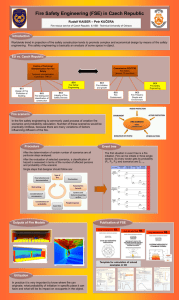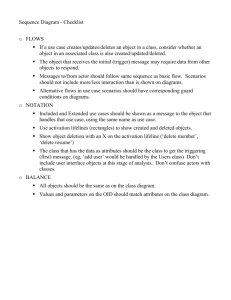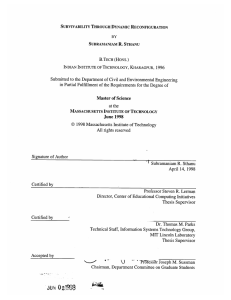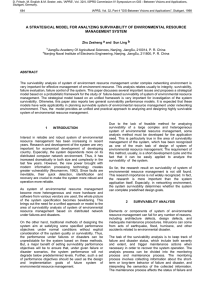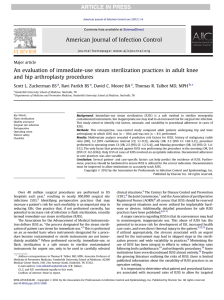here - OoCities
advertisement
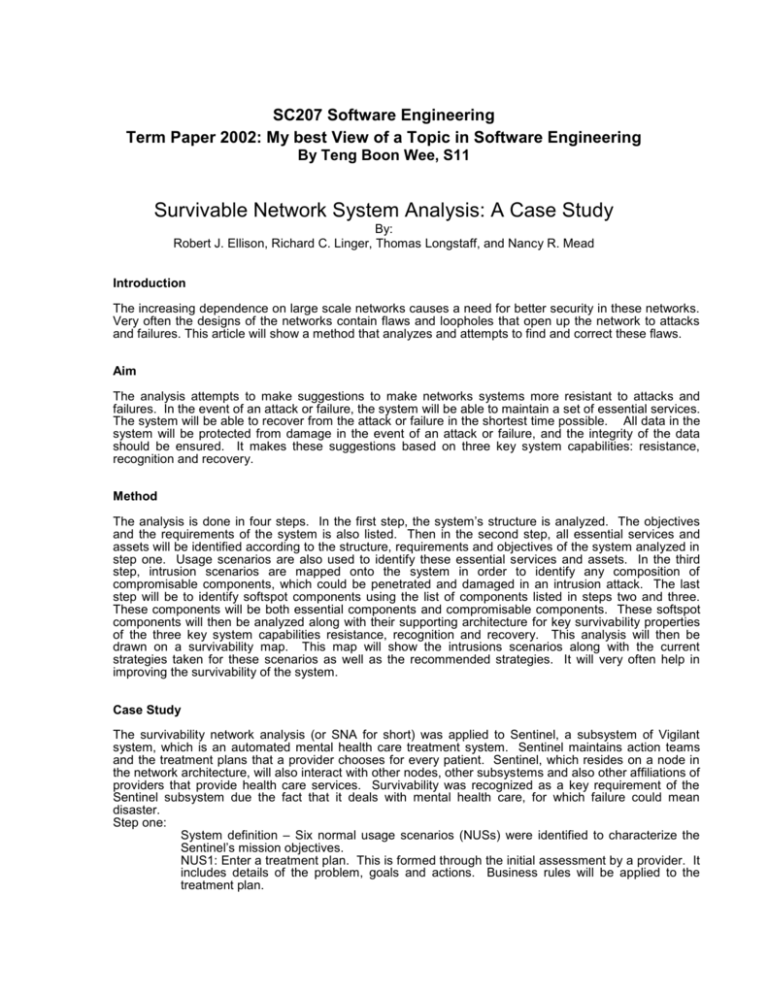
SC207 Software Engineering Term Paper 2002: My best View of a Topic in Software Engineering By Teng Boon Wee, S11 Survivable Network System Analysis: A Case Study By: Robert J. Ellison, Richard C. Linger, Thomas Longstaff, and Nancy R. Mead Introduction The increasing dependence on large scale networks causes a need for better security in these networks. Very often the designs of the networks contain flaws and loopholes that open up the network to attacks and failures. This article will show a method that analyzes and attempts to find and correct these flaws. Aim The analysis attempts to make suggestions to make networks systems more resistant to attacks and failures. In the event of an attack or failure, the system will be able to maintain a set of essential services. The system will be able to recover from the attack or failure in the shortest time possible. All data in the system will be protected from damage in the event of an attack or failure, and the integrity of the data should be ensured. It makes these suggestions based on three key system capabilities: resistance, recognition and recovery. Method The analysis is done in four steps. In the first step, the system’s structure is analyzed. The objectives and the requirements of the system is also listed. Then in the second step, all essential services and assets will be identified according to the structure, requirements and objectives of the system analyzed in step one. Usage scenarios are also used to identify these essential services and assets. In the third step, intrusion scenarios are mapped onto the system in order to identify any composition of compromisable components, which could be penetrated and damaged in an intrusion attack. The last step will be to identify softspot components using the list of components listed in steps two and three. These components will be both essential components and compromisable components. These softspot components will then be analyzed along with their supporting architecture for key survivability properties of the three key system capabilities resistance, recognition and recovery. This analysis will then be drawn on a survivability map. This map will show the intrusions scenarios along with the current strategies taken for these scenarios as well as the recommended strategies. It will very often help in improving the survivability of the system. Case Study The survivability network analysis (or SNA for short) was applied to Sentinel, a subsystem of Vigilant system, which is an automated mental health care treatment system. Sentinel maintains action teams and the treatment plans that a provider chooses for every patient. Sentinel, which resides on a node in the network architecture, will also interact with other nodes, other subsystems and also other affiliations of providers that provide health care services. Survivability was recognized as a key requirement of the Sentinel subsystem due the fact that it deals with mental health care, for which failure could mean disaster. Step one: System definition – Six normal usage scenarios (NUSs) were identified to characterize the Sentinel’s mission objectives. NUS1: Enter a treatment plan. This is formed through the initial assessment by a provider. It includes details of the problem, goals and actions. Business rules will be applied to the treatment plan. NUS2: Update a treatment plan. The treatment plan will be reviewed by the provider. Problems, goals and actions will be added or changed. Again the business rules will be applied to the treatment plan. NUS3: View a treatment plan. A patient’s treatment plan can be viewed by a provider. The treatment plan must be current and correct. NUS4: Create and modify an action team. A patient’s action team membership can be defined or changed by a provider. The treatment plan must be current and valid. NUS5: Report the current treatment plans in an affiliation. An administrator views the current state of his/her affiliation’s treatment of a patient or a set of patients. The treatment plan summaries must be current and correct. NUS6: Change patient medication. A patient’s medical protocol is changed by a provider. Step Two: Step Three: Step Four: Essential Capabilities Definition – The services listed in step one were analyzed and NUS3 was identified as an essential service. This service was identified as a essential service as the treatment plans for the patients must be available at all times, especially for emergency cases. An essential asset was also identified as the treatment plans. The treatment plans must be kept confidential and their integrity must also be kept. The reporting engine and the database components, as well as their supporting components were also identified as essential assets. Compromisable Capability Definition – Five intrusion usage scenarios (IUSs) were tested on the system to identify compromisable components. IUS1: Data integrity and spoofing attack – The patient identifications of two validated treatment plans are swapped by an intruder. IUS2: Data integrity and insider attack – Treatment plans are modified or changed by an insider using other database clients. IUS3: Spoofing attack – An unauthorized user spoofs a legitimate users to view or modify treatment plans. IUS4: Data integrity and recovery attack – Major portions of the database are corrupted by an intruder. IUS5: Insider and availability attack – Sentinel’s software is destroyed or access to the software is limited by an intruder and treatment plans cannot be retrieved. These IUSs showed the vulunerabilities of the various components. All of the IUS revealed certain weakness in the security of the system. Survivability Analysis – By comparing the components listed in steps two and three, we have found a number of softspot components. The ways that the system component security can be compromised are listed in a table. They are listed according to intrusion scenarios. They are then analyzed according to the three key system capabilities resistance, recognition and recovery. The current strategies for each of the key system capability are listed. Recommended strategies are then added to the table. Gaps and weakness in the architecture are then analyzed to locate common points so that a single recommendation can deal with several intrusion scenarios. Using these suggested changes to the system, a modified architecture of the system was drawn to illustrate the changes to be made to the system. The details of the analysis are summarized in Figure 1 below. Step 1: Analyze System Architecture Step 2: Determine Essential Components Step 3: Determine Compromisable Components Step 4: Determine Softspot Components Draw Survivability Map Figure 1 – Flowchart of Analysis of Network Review Of Article The Survivability Network Analysis will help to ensure the integrity of networks, regardless of the size. Through this analysis, networks can be made more secure and less prone to attacks. In the case of failure, there is higher chance of the data being recovered faster. It uses Object Oriented Analysis to analyze the components in the system, as shown in the case study. The analysis in the case study is detailed and seems to be very effective. However, in order to apply this analysis to a network, much experience is required from the people doing the analysis, otherwise the IUSs used may not cover all the scenarios that may occur, hence leaving out some of the compromisable components. The changes proposed to be made to the system may also be too complex in some cases, requiring a total change in the system. The analysis method may be used when designing a new system and not just on existing systems. This will help to locate some of the flaws in the security of the system. Again, this will require a lot of experience from the designers, since they will not be able to guess the outcome of some of the scenarios accurately without ample experience. This will be harder than analyzing an existing system, since for an existing system the scenarios may be seen, while for a new system the designers have to imagine what the outcome of each scenario may be. But this analysis will help to make a very well-thought design. This system of analysis may help in the design of my project, which involves a server. The analysis will help to locate any areas in my design that are lacking in security and needs to be refined. For example, for the resistance key capabilities, the design lacks a system to protect the database, which is an essential component, from any intruder who accesses it. For the recovery key capability, the design does not have any backup of the database if anything should happen and corrupts the database. While not all the changes brought up by the analysis are feasible to be implemented, there will of course be many improvements that will be brought up by the analysis. The Survivable Network Analysis can be further improved by breaking down the types of IUSs that may occur, in order to guide the evaluators who may not be as experienced. Having different types of IUSs listed will help to ensure that the evaluators will not forget about a certain threat that exists. References and Related Works Author(s) CERT/ Coordination Centre RJ Ellison Richard C. Linger, Robert J. Ellison, Thomas A. Longstaff, and Nancy R. Mead Year Article Description Relation to present article 1999 The Survivable Network Analysis Method: Assessing Survivability of Critical Systems The implementation of the Survivable Network Analysis More detailed and focused version of the article 1998 A Case Study in Survivable Network System Analysis A case study of the implementation of the Survivable Network Analysis Another case study 2000 The Survivability Imperative: Protecting Critical Systems Security and the Survivable Network Analysis A more updated analysis of the analysis method



